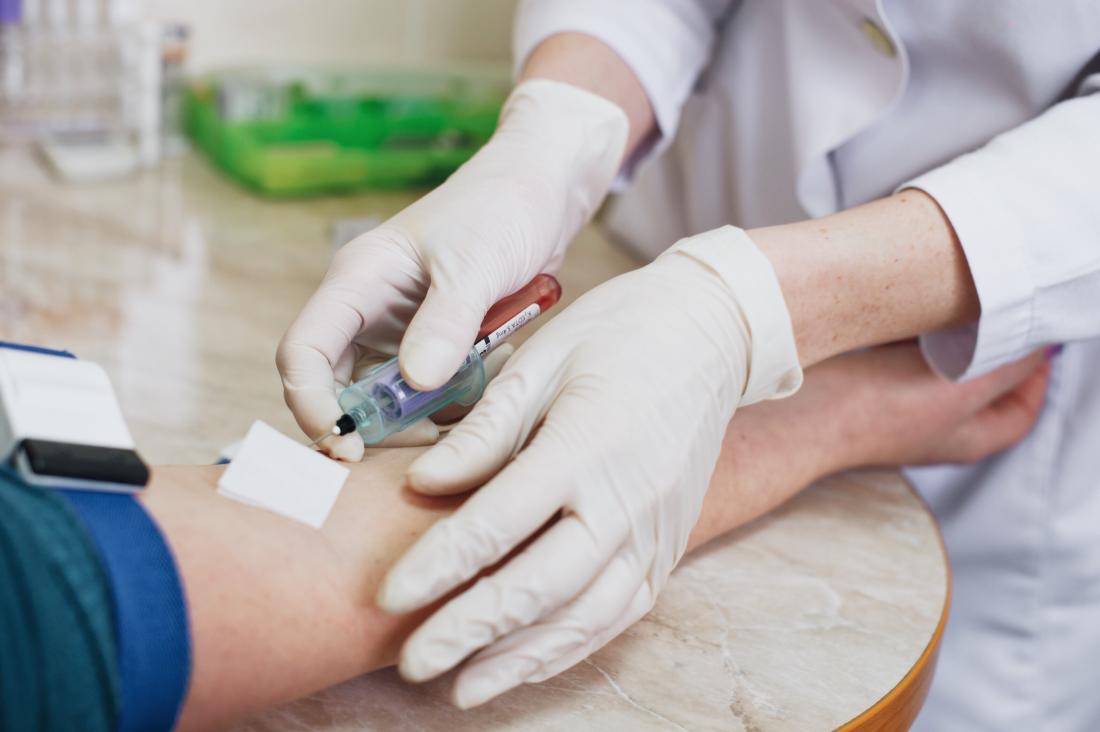In this article, we discuss the ferritin blood test procedure and how to interpret the results.
We also explain how people can raise or lower their blood ferritin levels.
What is a ferritin blood test?

A ferritin blood test can help a doctor diagnose conditions related to high or low iron levels.
Doctors use ferritin blood tests to check the levels of iron in a person’s blood and help diagnose many health conditions. These conditions include:
- iron-deficiency anemia, or a low red blood cell count
- hemochromatosis, a condition wherein there is too much iron in the body
- restless legs syndrome
People who have one of these conditions may require regular ferritin blood tests to monitor their health.
A doctor may also order other blood tests to discover more about a person’s iron stores. They may test for:
- blood iron levels
- hemoglobin levels, to check red blood cell numbers
- the HFE gene, which indicates hemochromatosis
- total iron binding capacity, which measures levels of transferrin, a protein that carries ferritin around the body
What do the results mean?
After a doctor takes the blood sample, they will send it to a laboratory for testing. Once the laboratory technicians analyze the blood, they will typically send the results back within a few days of the test.
Ferritin blood test results may come back as normal, low, or high. The following sections discuss what these results mean.
Normal ferritin levels
Results will be given in nanograms per milliliter (ng/mL) of blood and can vary slightly from one laboratory to another.
According to some sources, the normal ranges for ferritin in the blood are as follows:
| Group | ng/mL |
| Adult males | 20–250 |
| Adult females | 10–120 |
| Females over 40 | 12–263 |
| Newborns | 25–200 |
| Infants aged 1 month | 200–600 |
| Infants aged 2–5 months | 50–200 |
| Children aged 6 months to 15 years | 7–140 |
Other sources provide slightly different levels, with some research from 2008 suggesting that some laboratories consider ferritin levels over 200 ng/mL in women and 300 ng/mL in men to be abnormal.
It is important that people confirm normal levels with their doctor or the laboratory that tested them.
Low ferritin levels

Low ferritin levels can cause headaches and pale skin.
A result of low ferritin is strong evidence of an iron deficiency. The body requires iron to make hemoglobin, which is a protein in red blood cells that transfers oxygen from the lungs around the body.
Without enough iron, a person may develop anemia.
Iron is also necessary for:
- growth and development
- normal metabolism
- the production of hormones
Iron-deficiency anemia can cause the following:
Mild anemia may not produce any symptoms.
High ferritin levels
Higher-than-normal ferritin levels may result from:
- hemochromatosis
- chronic inflammatory conditions, such as rheumatoid arthritis
- heavy alcohol use
- Hodgkin lymphoma, a cancer that affects the lymphatic system
- hyperthyroidism, wherein the thyroid gland produces too much thyroid hormone
- leukemia, a cancer of the bone marrow
- liver disease
- porphyria, a group of disorders that affects the skin and nervous system
People who have had several blood transfusions may also display high ferritin levels.
A result of above-normal ferritin levels will require further testing to discover the underlying cause and help doctors determine the best course of treatment.
How to increase low ferritin levels
Doctors treat low ferritin levels with oral iron supplements. For severe cases of anemia, a person may require treatment with intravenous iron.
For the best results, people should take oral iron supplements with a source of vitamin C to increase iron absorption. They should avoid antacids, calcium supplements, and tea or coffee within 2 hours of an iron supplement.
Typically, people will require follow-up blood tests to check that their ferritin levels and iron levels have returned to normal.
If ferritin and blood iron levels do not return to normal following iron supplementation, a doctor may carry out additional testing to determine the cause of the deficiency and treat it accordingly.
Potential causes of an iron deficiency include:
How to lower high ferritin levels

A doctor may recommend phlebotomy to treat high ferritin levels.
The treatment for high ferritin levels depends on the underlying cause.
For hereditary hemochromatosis, doctors typically recommend a person have their blood removed from their body, in a process called phlebotomy, on a regular basis.
The amount of blood that the doctor removes, and how frequently they remove it, will vary depending on a person’s age, health, and ferritin levels. At first, the person may require the removal of around 500 ml of blood weekly until their ferritin levels return to normal.
These people will need treatment on an ongoing basis to maintain normal blood ferritin levels.
Those with other conditions causing high ferritin levels may require additional treatments, such as medications or procedures, depending on the cause.
Procedure
A ferritin blood test follows a similar procedure to other types of blood test.
Typically, a medical professional will begin by cleaning the skin around the puncture site using an alcohol-based solution. Usually, they will take the blood from a vein on the inside of the elbow.
They may first wrap an elastic band around the upper arm to make the vein more prominent. They will then insert the needle, which is connected to a vacuum collection device, into the vein. People may feel a slight pinch as the needle enters the skin.
Once they have collected the blood, the doctor will withdraw the needle and remove the elastic band if one is present.
They will sometimes use some cotton wool or a bandage to stop any bleeding, before labeling the blood sample and sending it to a laboratory to be analyzed.
The blood collection process only takes a few minutes. It is unlikely for a person to experience side effects, and when they do occur, they are typically mild. For example, some people may experience:
- dizziness or nausea at the sight of the blood
- mild bruising in the hours or days after the test
People may wish to let the doctor know before the test if they are feeling anxious or uncomfortable.
How to prepare for the test
People do not usually need to make any special preparations for a ferritin blood test. However, if a person is also having other blood tests, they may need to fast for a certain period of time beforehand.
Individuals should confirm these details with their doctor in the days leading up to the blood test.
Summary
A ferritin blood test is a simple blood test to measure the levels of ferritin in a person’s body. It is a very safe procedure that does not usually require any special preparations.
Abnormal results may indicate an underlying issue, such as iron deficiency, hemochromatosis, or some types of cancer. Further testing is typically necessary to confirm a diagnosis and help formulate a treatment plan.
If people are confused about the results of their ferritin blood test, they should follow up with their doctor, who can explain the results and their implications.

